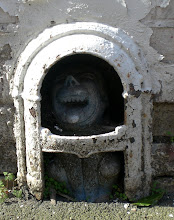 You might recall a posting in the spring regarding an intriguing white stone near the windmill on Wimbledon Common. I was lucky enough to be able to identify it as being a benchmark used in
You might recall a posting in the spring regarding an intriguing white stone near the windmill on Wimbledon Common. I was lucky enough to be able to identify it as being a benchmark used in surveying as I had spotted something similar the previous week on a kerb in Brentford. Although I was feeling quite pleased with myself at this bit of sleuthery there are, of course, always those out there who know an awful lot more about the subject. Cheltonia left a comment suggested that it was actually a special type of benchmark called a rivet so I thought some extra checking might be in order.
It didn't take much work before I was reading a site called The Bench-Mark Database and my eyes were opened to a whole new world of benchmarks and their variants all being meticulously researched and catalogued by a group of dedicated enthusiasts. You might not think this would be much of a problem but it seems that through the history of the Ordnance Survey almost every survey has varied the benchmarks used so there are layers of benchmarks of different vintage and importance.
The database allows you to locate benchmarks in your area so it might be worth having a look to see if there are any unusual examples in your area, and although by no means complete, new ones are always being added. As I couldn't find my Wimbledon one on the database I wrote to the site explaining my query and asking if they could provide any background information on what it might be. Ian, the site owner, responded with a very full and informative answer which he kindly allowed me to repeat verbatim. The main question then, was what type of benchmark was it?
It's a Ordnance Survey rivet bench mark. The stone wasn't put there by the OS - it's a boundary stone which was already there and the OS used it as a handy location on which to place their bench mark. You quite often find rivets on boundary stones, milestones, and even large boulders. As long is it is not likely to move the OS might have put a bench mark on it.
My database has all the UK fundamental bench marks (about 200), and almost all the flush bracket bench marks (about 21,000). There are about 500,000 lower order bench marks in Britain, such as this rivet, but I don't have anything like full coverage for them. They are just added to the database by users of the site as and when they log them.
Using the windmill in the background of your photograph, I was able to guess at the location of this stone as somewhere in OS grid square TQ2372. I looked at this square in the Ordnance Survey's own database and found the following:
TQ 2303 7250 RIVET TOP BS 20.0M E PUBLIC CAR PARK 52.0321 3 N 1972 - 0.6
Translating this to English: TQ 2303 7250 is the grid reference of the bench mark. The description is "Rivet on top of boundary stone, 20 metres east of the public car park". The rivet was measured at 52.0321 metres above sea level. It's a 3rd-order bench mark. The height above sea-level is relative to the sea level at Newlyn in Cornwall. It was last checked by the OS in 1972. The rivet is about 0.6 metres above ground level.
Looking again at the map near the windmill, I can see both a car park and parish boundary line, and a nearby 50m contour line, which ties up nicely with the description given.
Rivets like this were part of the OS levelling network. Levelling was the process of measuring the hight above sea level of a given point. The surveyors started at Newlyn and moved out across the country measuring from point to point. From this they built a series of very precise bench marks called fundamental bench marks (FBM), such as this one at Croydon with levelling lines running between the FBMs marked every mile or so with a flush bracket (FB) bench mark. The points between the FBs were filled in with lower order bench marks, such as rivets, bolts, and stone cuts.
These days levelling is done using satellites and GPS measurements. Apart from the FBMs, the old levelling network is no longer used or maintained by the OS and the old survey marks are slowly being lost as roads are widened, buildings are demolished etc.
So it looks as though our Wimbledon rivet was one of the lowest order of benchmarks and sited for convenience on top of a pre-existing parish boundary stone and for all intents and purposes became obsolete in about 1972. Not the most earth-shattering of revelations but I have to say that one of the bonuses of noticing it in the first place has been the subsequent discovery of the world of the Ordnance Survey benchmark!


























